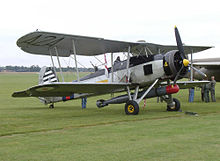
811 Naval Air Squadron was a unit of the British Royal Navy's Fleet Air Arm. It was first founded in 1933, and served during World War II, seeing action in the battle of the Atlantic and on Russian convoys, and was eventually disbanded in 1956.

HMS Nairana was the lead ship of the Royal Navy's Nairana-class escort carriers that saw service in the Second World War. She was built at John Brown & Company shipyards in Clydebank, Scotland. When construction started in 1941 she was intended as a merchant ship, but was completed and launched as an escort carrier, entering service at the end of 1943.
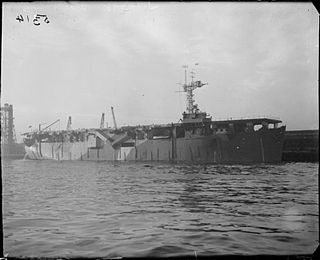
HMS Vindex (D15) was a Nairana-class escort carrier of the Royal Navy that saw service during the Second World War. She was built at Swan Hunter shipyards in Newcastle upon Tyne. When construction started in 1942 she was intended as a merchant ship, but was completed and launched as an escort carrier, entering service at the end of 1943.

The Nairana-class escort carrier was a British-built class of three escort carriers. They were constructed one each in England, Scotland and Northern Ireland to the same basic design during the Second World War for service with the Royal Navy.

815 Naval Air Squadron is a Royal Navy Fleet Air Arm squadron flying the AgustaWestland Wildcat HMA.2 helicopter and is the Navy's front line Wildcat Naval Air Squadron. The squadron is based at RNAS Yeovilton in Somerset. The squadron is capable of carrying out multiple roles such as: counter-narcotics, anti-piracy, Above Surface Warfare (ASW), search and rescue, disaster relief and flying and engineering training. In the early 2000s, the Navy said that the squadron was largest helicopter squadron in Europe.

Royal Naval Air Station Hatston, was a Royal Naval Air Station, one mile to the north west of Kirkwall on the island of Mainland, Orkney, Scotland. It was located near the strategically vital naval base of Scapa Flow, which for most of the twentieth century formed the main base of the ships of the Home Fleet. The airbase was designed to provide accommodation for disembarked Front-Line squadrons and accommodation for disembarked Ship's Flight Aircraft and was home to the Home Fleet Fleet Requirements Unit, 771 Naval Air Squadron.
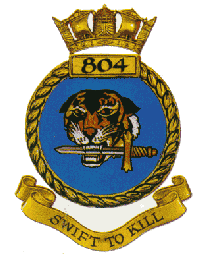
804 Naval Air Squadron was a Naval Air Squadron of the Royal Navy, formed in November 1939 from part of 769 NAS Sea Gladiators which had been detached to RNAS Hatston. The squadron was merged into 800 NAS in June 1944 and subsequently reformed in September.
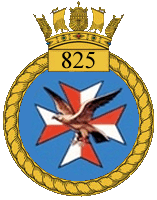
825 Naval Air Squadron is a Royal Navy Fleet Air Arm Naval Air Squadron which was re-commissioned on 10 October 2014 and currently flies the AgustaWestland Wildcat HMA2.
823 Naval Air Squadron was a Fleet Air Arm aircraft squadron before and during World War II.
740 Naval Air Squadron was a Naval Air Squadron of the Royal Navy's Fleet Air Arm. It was formed in 1943 as an Observer Training Squadron at RNAS Arbroath, disbanding the same year. From 1943 to 1945 it was a Communications Squadron based at RNAS Machrihanish.

748 Naval Air Squadron was a Naval Air Squadron of the Royal Navy's Fleet Air Arm. It was initially formed, at RNAS St Merryn, as a Fighter Pool Squadron, before becoming No. 10 Naval Operational Training Unit. The squadron moved to RNAS Henstridge in February 1944 and then onto RNAS Yeovilton in the March. In September 1944, 748 NAS moved to RNAS Dale, in Wales, remaining for just under twelve months, before moving back to RNAS St Merryn in August 1945, where it disbanded in February 1946. During its existence, the squadron was equipped with numerous aircraft and various marks, operated by the Fleet Air Arm.
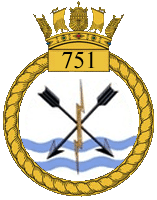
751 Naval Air Squadron was a Naval Air Squadron of the Royal Navy's Fleet Air Arm. It was initially active as an Observer Training Squadron from 1939 to 1944 as part of No.1 Observer School. 751 Naval Air Squadron formed at RNAS Ford in May 1939. Ford was attacked and bombed, in August 1940, and the following day the squadron relocated to RNAS Arbroath. Twelve months later it moved to RNAS Dundee, remaining there until disbanding at Dundee in May 1944.

759 Naval Air Squadron was a Naval Air Squadron of the Royal Navy's Fleet Air Arm. It was created on November 1, 1939, and was disbanded on December 24, 1969. It was initially intended as a Telegraphist Air Gunner Training Squadron but became a Fighter School and Pool Squadron in 1939, at RNAS Eastleigh. It operated out of RNAS Yeovilton from 1940 to 1946, as part of the Naval Air Fighter School. In 1943 a detachment operated out of RNAS Angle, working with 794 NAS and known as the Naval Air Firing Unit. It was again the Naval Air Fighter School upon reformation in 1951 and disbandment in 1954, firstly at RNAS Culdrose and then moving to RNAS Lossiemouth, in 1953. The squadron reformed again, this time at RNAS Brawdy in 1963, as the Naval Advanced Flying Training School, before finally disbanding in 1969.

766 Naval Air Squadron was a Naval Air Squadron of the Royal Navy's Fleet Air Arm. It was to have initially formed in 1939 at RNAS Lee-on-Solent, as a Seaplane School, however, it formed at RNAS Machrihannish as a Night ALT Course, in 1942. It moved to RNAS Inskip, in 1943, to become part of No. 1 Naval Operational Training Unit. By 1944, it was operating over 30 swordfish aircraft, but, during the year, also acquired Firefly aircraft from 1772 NAS, and Sea Hurricane aircraft from 760 NAS. It moved to RNAS Rattray early in 1946, but later that year, moved to RNAS Lossiemouth where it received Seafire aircraft, along with being Part 1 of the Operational Flying School. By late 1951, Sea Fury trainer aircraft were also added to its varied list of types operated. In 1953, the squadron moved to RNAS Culdrose, where it disbanded in 1954.
784 Naval Air Squadron was a Naval Air Squadron of the Royal Navy's Fleet Air Arm which last disbanded in the autumn of 1946. 784 NAS was a night fighter training squadron which formed at HMS Daedalus, RNAS Lee-on-Solent, Hampshire, in June 1942, moving to HMS Nighthawk, RNAS Drem, East Lothian, in October 1942. Squadron Personnel were also detached to the Naval Air Radio Installation Unit at RAF Christchurch in 1943 and in the same year, a number of crews were attached to RAF night fighter squadrons, with two officers gained DFCs. In 1944, three squadron Flights were attached for service to each of 813, 825 and 835 Naval Air Squadrons, embarked in HMS Campania, HMS Vindex, and HMS Nairana respectively, on convoy protection duties. At the beginning of 1946 the squadron moved to Wales, operating out of HMS Goldcrest II, RNAS Brawdy.

787 Naval Air Squadron was a Naval Air Squadron of the Royal Navy's Fleet Air Arm which disbanded in January 1956. It formed in March 1941, at HMS Heron, RNAS Yeovilton, out of 804 Naval Air Squadron as a Fleet Fighter Development Unit. Almost every type of fighter was received by the squadron for testing and evaluation for naval use. A move to RAF Duxford in June 1941 saw it become the Naval Air Fighting Development Unit, attached to the Royal Air Force's Air Fighting Development Unit. The squadron undertook rocket projectile test, continuous development of fighter tactics and even helping Torpedo Bomber Reconnaissance squadrons in evading fighter attack. Post Second World War it continued its trials task and also undertook Rebecca radar trials and ASH, US-built air-to-surface vessel radar trials.

790 Naval Air Squadron was a Naval Air Squadron of the Royal Navy's Fleet Air Arm which disbanded in November 1949 at RNAS Culdrose. It initially formed during 1941 as an Air Target Towing Unit, at HMS Landrail, RNAS Macrihanish, in Scotland, from elements of two other Fleet Air Arm squadrons, however, this only lasted for three months and the unit was disbanded, absorbed into 772 Naval Air Squadron. It reformed the following year, in July 1942, tasked as a Fighter Direction Training Unit, at RNAS Charlton Horethorne. It provided support for the Fighter Direction School and had short spells at RAF Culmhead and RNAS Zeals, before reloacting to RNAS Dale in Pembrokeshire, next to the new purpose built Air Direction School, HMS Harrier or RNADC Kete, in 1945. The squadron moved to HMS Seahawk in Cornwall during December 1947.

791 Naval Air Squadron was a Naval Air Squadron of the Royal Navy's Fleet Air Arm which last disbanded at Sembawang in June 1947. It formed as an Air Target Towing Unit, at HMS Condor, RNAS Arbroath, in Scotland, in October 1940. It operated various types of aircraft for target towing duties, used to support air gunnery training and practice. The squadron disbanded in December 1944, at Arbroath. It reformed at RNAS Trincomalee, in British Ceylon,, in November 1945, as a Fleet Requirements Unit. The squadron moved to RNAS Sembawang, in Singapore, in December 1945, ferried via the escort carrier, HMS Smiter. It also operated a Communications Flight and an Air-Sea Rescue Flight, as well as undertaking anti Mosquito spraying duties.

794 Naval Air Squadron was a Naval Air Squadron of the Royal Navy's Fleet Air Arm which disbanded in March 1947. The squadron formed as an Air Target Towing Squadron, at HMS Heron, RNAS Yeovilton, during August 1940, although operated target tug aircraft out of the satellite, RNAS Haldon. In April 1943 it provided a detachment at RAF Warmwell as an air firing unit and three months later the squadron relocated to RNAS Angle and became the Naval Air Firing Unit. Further moves followed in quick succession, to HMS Goldcrest, RNAS Dale, in September, HMS Dipper, RNAS Henstridge, in November and HMS Heron II, RNAS Charlton Horethorne in December and by which time the squadron was designated No. 1 Naval Air Firing Unit, but disbanded in June 1944. The squadron reformed at HMS Vulture, RNAS St Merryn, in January 1945, as the School of Air Firing and later in the year was tasked to support the newly-formed Ground Attack School. It moved to HMS Gannet, RNAS Eglinton, during August, and at this point had three flights providing courses for aerial warfare, airstrike and aerial reconnaissance.

Royal Naval Air Station Twatt, is a former Royal Navy Air Station located near Twatt, Orkney, Scotland. It was built by the Admiralty and was commissioned on 1 April 1941. On 1 January 1942 it became an independent command as HMS Tern. The airbase was designed to provide accommodation for disembarked Front-Line squadrons and accommodation for disembarked Ship's Flight Aircraft and was home to the Home Fleet Fleet Requirements Unit, 771 Naval Air Squadron.



